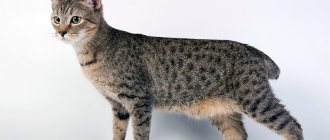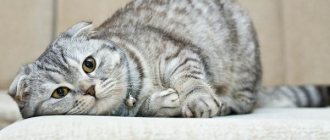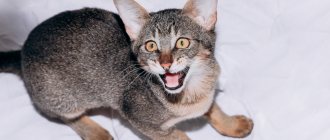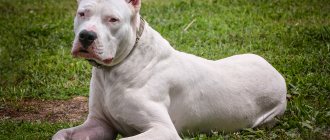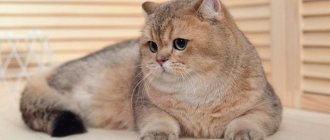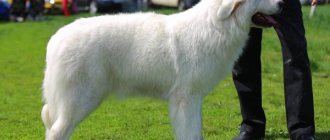History of the origin of the breed
The homeland of Siamese cats is Thailand, which in ancient times was called Siam, hence the name of the cat. The breed has an ancient past. In Thailand, “moon diamond” cats, as the locals romantically called cats, were known already in the 14th century. Siamese cats were considered sacred animals and were only owned by monks and members of the royal family. Until the 19th century, Europe and America knew nothing about the unusual breed - cats were forbidden to be exported from the country.
Read : what to name a Siamese cat.
In Europe, the first cats were introduced to the public at an exhibition at the Crystal Palace Cat Show in 1871. The first Siamese cat was brought to the United States as a gift to Lucy Hayes, the wife of President Rutherford B. Hayes in 1878. David brought the cat. B. Sickels is an American diplomat stationed at the consulate in Thailand.
The breed was not immediately able to gain popularity among cat lovers - these oriental beauties had too exotic an exterior. Today this breed is very popular and recognized by all international cat associations.
Appearance
The Siamese cat is distinguished by its special gracefulness, diminutiveness and a certain majesty that is characteristic of its character. Siamese kittens are the only ones that have not been crossed with cats from Europe, which has preserved the pristine nature of their eastern roots.
Breed standard according to the WCF system
- Body . Elongated, elegant proportions. Not large. Slim and muscular.
- Head. It has a wedge shape. The wedge starts at the tip of the nose, then widens in straight lines to the ears.
- Muzzle. Narrow.
- Neck. Slender and long.
- Ears. Positioned as a continuation of the wedge of the head. Very big. Wide at the base and narrowed at the tips.
- Chin. Forms a vertical line with the tip of the nose.
- Nose. Straight and long.
- Eyes. Almond shaped. Rich blue color. Located at a slight angle.
- Limbs. Slender and long. The hind ones are longer than the front ones.
- Paws. Oval, graceful shape.
- Tail. Thin at the base and along the entire length, very flexible and long. The tip of the tail is pointed.
- Wool. Short without undercoat. Glossy and silky. Fits tightly to the body.
- Color. There are about 20 varieties of colors. A prerequisite is the presence of “points” - spots darker than the main color on the face, ears, paws and tail.
- Weight. Not described in the breed standard. From 3 to 6 kg.
- Height at withers . Not described in the breed standard. From 23 to 25 cm.
- Lifespan . Representatives of the breed are considered long-livers. On average they live from 14 to 25 years.
Important!
The Guinness Book of Records records a Siamese cat that lived for 38 years.
Breeding
To get purebred Siamese kittens, you need to choose a pair; the males should not be much larger than the female, so that the kittens are of medium size and can easily fit through the mother’s narrow pelvis.
This is also important because with a weak spine the mother will find it difficult to bear large kittens.
To ensure that the birth goes smoothly and without complications, it is better to invite a veterinarian or at least have a doctor’s phone number who you can call in an emergency to save the life of the cat or its offspring.
During pregnancy, the cat needs to be well fed, the dose of microelements and vitamins increased, and after giving birth it should also be fed well.
Colors of Siamese cats with photos
There are more than 20 varieties of Siamese cat colors.
The most famous colors of Siamese cats are as follows:
- Seal point (brown) is a cream color that can have shades to light brown. The points of this color are dark brown.
- Blue point (blue) is a snow-white color with a bluish tint to the points.
- Red point – white body, red (apricot) point. There may be streaks on the markings, which is not an abnormality.
- Caramel point (light cream). This color is slightly different from the traditional one, since the cat is neither white nor brown. Its color is a magnolia shade, and its points are gray-pink.
- Chocolate point (black). The body is ivory in color, and the markings can range from chocolate (café au lait) to black.
- Cinnamon point (ivory shade). The cat's body is ivory-colored, like a "chocolate" point, but the markings are pinkish-brown.
- Lilac point (pink). The cat's body is the color of beaten egg white, and the markings are light gray with pink tints.
- The Torty Point is a rather unusual color, distinguished by a colored mask and the same markings on the paws, tail and ears.
- The Tabby Point is distinguished by the fact that the markings have stripes. The body is pale, without shades (plain color).
Important!
The points are the result of the albinism modifier gene and appear as the cat grows older in colder areas of the body. Kittens are born completely white. With age they darken. In colder regions, Siamese cats have darker spots.
Care and maintenance
Shorthaired Siamese cats are clean by nature and require minimal grooming.
The most important thing is to provide cats with sufficient attention from the owner, care and affection. Then the myths about the breed’s viciousness of these cats will remain exclusively myths. In an atmosphere of love and care, these beauties turn into gentle, affectionate and devoted pets.
Content Features
Cats have very short hair with no undercoat, so they are very sensitive to cold. They can only be kept warm, in a place without drafts. The optimal temperature for kittens is 25-28°C.
If Siamese are kept in a cool room, it is necessary to insulate the resting place and organize a warm bed. During the cold season, you can place a heating pad wrapped in a towel on the mat. The breed is completely unsuited to being kept outdoors.
Cats are smart and quick-witted, they easily learn to walk on a leash (harness). Their habits are very similar to those of a dog; cats of this breed can be taught commands and tricks. Siamese love long walks and don’t mind going on trips themselves, so you need to keep an eye on windows and entrance doors. If left open, cats may escape.
Siamese cats are very sensitive, they can distinguish the intonations of a human voice and understand words. Besides, they are touchy. If you scold or punish your pet undeservedly, he may harbor a grudge and try to take revenge. Raising a Siamese kitten and an adult animal is necessary in an atmosphere of calm and love. Cats can become attached to one family member, choosing him as their owner. They experience separation from this person very painfully.
Siamese cats are active and love active games; they can run around the house for hours. It is important that they have enough space. All dangerous devices, electrical wires, and breakable furnishings must be removed out of the reach of cats. Please note that Siamese are very curious; the blood of a hunter and explorer flows in their veins. Cats can climb into closets, bedside tables, washing machines and other unexpected places.
In the absence of their owners, they can play pranks, sometimes their pranks have a destructive effect. Overturned flower pots, unwound balls and rolls of toilet paper, a reprogrammed TV receiver - all this may be waiting for you when you return home after work. Cats have nimble and very long fingers, and they quickly learn to use them.
To prevent your cat from destroying the apartment out of boredom and longing for its owners, buy it several logical puzzle toys. Siamese are smart, they enjoy playing with such toys. To implement cat activity, you can build or purchase a vertical multi-level house or play complex. But the best escape from boredom for a cat is a companion animal. Ideal companions for Siamese can be small active dogs or relatives with a similar temperament.
Smart cats learn to use the litter box quickly. The main motivators for them in this process are your attention and praise. The whip method should not be used with these cats. Unpleasant notes in the voice, coercion - all this will be perceived with hostility by the wayward and freedom-loving Siamese. An offended kitten may completely forget how to go to the litter box. Sometimes adult pets do this too - this is how they express protest and punish the owner.
Features of care
Cats have smooth, very short fur and no undercoat. These cats do not need to be combed - just run a damp hand or a massage mitt over the fur to collect dead hairs. And sometimes clean the fur on the ears with a piece of velvet cloth. But caring owners do not neglect this procedure; they brush their cats weekly with a wide-toothed comb or a brush with natural bristles. To add shine to the coat at the end of the procedure, use suede.
Siamese don't like water. They don't like her in a panic. They have no undercoat - cats are cold all the time. Therefore, there is no need to rape an animal. Cats are bathed very rarely, only if their fur is heavily soiled with sticky, foul-smelling substances (oil, resin, paint). Immediately after the procedure, dry your pet and wrap it in a warm, dry towel. To quickly dry the animal, you can use a hairdryer.
Oriental beauties have a predisposition to dental problems. Sufficient attention should be paid to caring for the oral cavity and teeth. Your teeth should be examined and brushed weekly using a special toothpaste and brush. Siamese dogs are taught this procedure, which is not very pleasant for cats, from an early age. To cleanse the oral cavity, cats are given special treats. To promptly detect and remove tartar, pets are taken to a veterinarian.
The breed actively uses a scratching post, this is how the claws are worn down naturally. If this is not enough, you need to trim the claws with a nail clipper and trim them with a special nail file. This must be done carefully and very carefully. Remember that Siamese are sensitive, if you hurt them, cats may be offended. Ask your veterinarian to show you how to trim nails correctly.
Your pet's large ears should be inspected once a week to check for unpleasant odors, crusts, and unnatural discharge. All this is a reason to take your cat to the veterinarian. If everything is fine with the ears, they are cleaned with a cotton swab dipped in Vaseline oil. Cotton swabs are not suitable for cleaning cat ears. The veterinarian may recommend another product from a veterinary pharmacy to clean the ears.
The beauty's almond-shaped eyes can sometimes turn sour. If this happens rarely and the discharge from the eyes is colorless and odorless, there is no reason to worry. It is enough to examine and wipe your pet’s eyes with a cotton pad dipped in warm boiled water. Purulent and profuse discharge is a reason to consult a veterinarian.
Siamese cats are incredibly clean. Therefore, owners will have to wash bowls with hot water immediately after eating. You need to do this every day. The feeding area must also be kept clean.
Siamese do not like unpleasant odors and may refuse to eat in a dirty place. Also, you need to carefully clean the cat's litter box - clean Siamese will not do their business in a dirty litter box.
Important!
Place the tray as far away as possible from the place where food and water bowls are located. Siamese will not eat where they are toileting. Food bowls are placed in a secluded, quiet place.
Upbringing
By the time they move to a new home, Thai kittens have already mastered the basic rules of behavior well and know how to use a scratching post and litter box. To make the process of getting used to a new place of residence quick and painless, try to create an environment for your baby that is similar to the one in which he spent the first months of his life. Talk to your pet calmly, without raising your voice unnecessarily. A Thai will quickly understand that if they are dissatisfied with him and loudly scold him, then he has really done something wrong. Keep the use of harsh measures to a minimum. Aggression can only breed aggression. You can calm an overly angry cat with a stream of cool water. This is not painful or humiliating for the royal cat, unlike physical punishment.
Provide your baby with enough toys. This will distract him from mischief and protect your things from damage. Keep valuable items and papers out of reach of the animal.
Having a cat in the house is both a great joy and a huge responsibility. And this responsibility lies with the individual.
How much money do you need for care and maintenance?
What to buy for a kitten
Required set:
- Two or three bowls (depending on the type of feeding). Choose a large water bowl - Siamese often like to drink from large containers. Price: 150 – 320 rub.
- Tray. Large with deep sides: 250 – 1350 rub.
- Wide-toothed comb or brush with natural bristles: RUB 350 – 650.
- Scratching post: 900 – 2500 rub.
- Toys. Choose intellectual ones and those that you can run after. Price: 600 – 3500 rub.
- Plastic carrier with metal door. Price: 1250 – 2600 rub.
- Bed. Warm with sides: 500 – 2000 rubles.
Additional products:
- Vertical game complex. Price: 5000 – 32000 rub.
- Claw cutter. Price: 350 – 590 rub.
- Harness with leash. Price: 850 – 1600 rub.
- Anti-cat bars for windows. Price: 1800-2450 rub.
- Automatic drinking fountain. Some Siamese cats love to drink running water. Price: 1800 – 4800 rub.
The annual care of a Siamese cat may require from 20 to 40 thousand rubles.
The budget will depend on your capabilities, the chosen diet, the type of filler and the health of the pet.
Health and illness
Genetic breed abnormalities
The Siamese cat has congenital pathologies that are unique to this breed:
- Congenital strabismus. Visual impairment due to pathology of the development of the eyeball. Develops in cats with the acromelanism gene (Siamese, Thai). The gene affects the ability to see the world in a stereoscopic dimension. Because of this feature, Siamese see everything in a flat image.
- Broken tail. A crease in the tail is a sign of a breed defect. Curvature of the vertebrae leads to permanent pinching of nerve endings. Cats with this defect constantly experience pain and discomfort and can be aggressive because of this.
Important!
In the USSR it was believed that a real Siamese cat should have a kink in its tail and slanted eyes. In addition, they must be aggressive and vindictive. This happened due to the fact that it was very expensive to introduce a real purebred animal into the country; they brought rejected animals with developmental anomalies.
Other health problems
The unique wedge-shaped shape of the head and jaws means that cats of this breed swallow food without chewing. Because of this, plaque and tartar form, and periodontal disease develops. It is important to regularly care for the oral cavity and teeth, and choose food of such a shape and size that the cat is forced to chew it.
The lack of undercoat and the wedge-shaped narrow head of the cat make the animal vulnerable to various respiratory diseases. It is important to prevent your pet from becoming hypothermic, not to allow him to drink cold water, or to be in a draft.
Siamese cats often have:
- Amyloidosis. A pathology in which protein is deposited in the liver and kidneys of an animal. Causes chronic renal and liver failure.
- Glaucoma. Occurs due to increased eye pressure. May lead to retinal atrophy and blindness.
- Bronchial asthma.
- Hyperthyroidism. Pathology of the thyroid gland. Possible increased appetite, thirst, weight loss.
- Aortic stenosis. Congenital heart pathology, characterized by narrowing of the aortic opening. With this pathology, blood circulation is impaired.
- Dilated cardiomyopathy (enlargement of the heart). Genetic pathology leading to heart failure.
Important!
Keep in mind that Siamese cats are highly sensitive to anesthesia and this factor is important to consider when performing operations.
Prevention methods
To avoid these health problems, you need to take a responsible approach to choosing a kitten, ask the breeders for its documents and the documents of its parents, as well as the results of genetic tests.
The mandatory list of treatment and preventive measures should include:
- vaccination according to schedule;
- antiparasitic treatment;
- anthelmintic measures;
- vitaminization.
If a cat is not purchased for breeding, in the first year of life it is necessary to decide on its sterilization (castration).
Annually, treatment and preventive measures may require from 3,000 to 5,000 rubles.
Character of Siamese
Siamese are known for being one of the most intelligent and vocal cats in the world and will happily spend time with their owners. Siamese cats are affectionate with domestic cats, however, they can be demanding and suspicious of strangers. Many people say that their Siamese pets greet strangers at the door and go through some kind of approval process before visitors enter the house.
At the same time, Siamese cats are very active and love active games with toys. When it comes to training, they do not have any special exercise needs because Siamese cats are very active and playful in their own right.
They quickly get accustomed to the litter box and scratching post; the main thing is not to shout or force the cat to do anything. Siamese are quite proud and can become stubborn from such treatment. You can even toilet train them if you start training them when they are young.
You should not get a Siamese cat if you are often away from home. The pet will get bored and entertain itself in any of the available ways.
The stereotype about the evil character and vindictiveness of the Siamese, as a distinctive feature of the breed, originated in the USSR. The price of a purebred Siamese cat was high, so we usually received rejected kittens with squints, creases in the tail and abnormalities.
Feeding
The choice of food for a Siamese cat should be approached as responsibly as possible. These exotic oriental beauties are considered too picky when it comes to food and can show fickle tastes. Some of their preferences cause sincere bewilderment among the owners.
For example, a Siamese can happily eat nuts or mushrooms. They also love different fruits. But you shouldn’t indulge your pet; the owner must provide the cat with a balanced, properly selected diet. Whether it is natural food or feeding with ready-made food is up to you.
Natural nutrition
The basis of the natural diet of all cats should be meat. When creating a menu for a Siamese cat, you need to take into account the fact that representatives of this breed have darker fur from excess red meat in their diet. Therefore, 30% of animal proteins should come from fish.
Animal proteins should make up 70% of the menu:
- lean meat (rabbit, beef, turkey, chicken breast, lamb, game);
- sea fish (navaga, cod, tuna, flounder);
- shrimps;
- quail eggs;
- beef liver – 1-2 times a week.
What else should be in the diet:
- skim cheese;
- kefir, yogurt, fermented baked milk;
- vegetables (carrots, broccoli, zucchini, pumpkin, squash, cauliflower);
- fruits (apple, pear, banana) - as a treat;
- olive oil;
- greens (spinach, lettuce);
- Brewer's yeast;
- bran;
- dried seaweed (kelp).
All cats on a natural diet are prescribed vitamin and mineral complexes.
Prohibited products:
- bones (chicken, fish);
- milk;
- sweets;
- flour;
- onion garlic;
- fatty pork;
- sausage;
- legumes;
- smoked meats
- spices.
The daily serving volume is calculated using the formula: 7-7.5% of the cat’s weight. Adult cats need two meals a day.
Important!
Don't forget about access to clean water. It should be open 24/7. Many Siamese love to drink from large dishes and from the tap - pour water into a large container or buy a fountain drinker.
The monthly budget for a natural diet is 1000-1500 rubles.
Industrial feed
When making a choice in favor of one or another ready-made food, you need to assess the condition of your pet, its age and level of mobility. Avoid cheap “economy class” food from the beginning. High-quality brands of the “super-premium” and “holistic” classes are suitable for purebred cats. Do not forget about the breed characteristics - alternate meat and fish compositions.
Recommended brands:
- Orijen Cat Six Fish Grain Free – high-quality dry diet of holistic fish;
- Acana Regionals Grasslands Cat Grain-Free – dry meat and fish formula;
- Bozita Feline Shrimps - Chunks in Sauce - a wet diet based on meat and shrimp;
- 1st Choice Adult Cat Finicky Chicken Formula – for adult picky cats;
- Optima Nova Adult Cat Exquisite Chicken & Rice – with rice and chicken for picky-eating pets;
- AATU For Cats Free Run Chicken - food based on chicken and salmon;
- Royal Canin Siamese Adult – for adult Siamese cats.
The daily feeding rate is calculated based on the age, weight and activity of the pet. On average, Siamese cats need 45-70 grams of dry food per day.
Every month it will cost from 900 to 2300 rubles to feed a cat.
Read more about top cat foods and what to feed Siamese kittens.
FAQ
How many live at home?
Cats living in a family can live a long life - 15-25 years. Among the representatives of the breed there are long-lived cats that have lived for more than 35 years.
What is the weight of an adult and a kitten?
Siamese cats are slightly larger than females. At three months, cats weigh 1-1.5 kg, females - 1.3-2.8 kg. By six months, cats reach a weight of 1.7-2.4 kg, males - 2.3-4.1 kg. Adult females weigh 3.1-4.2 kg, males - 4-6.1 kg.
Is it easy to hold?
Siamese are affectionate and gentle towards their people. They can walk on their hands and sit on their knees. There are individuals who greet you at the doorstep and ask to be held in your arms. They may not go to strangers.
Can I keep it outside?
No. These cats are very sensitive to cold. They cannot be kept even in a cold room.
How aggressive is the breed?
The aggressiveness of Siamese cats is legendary. But these are just legends. True purebred Siamese are affectionate pets that become attached to people. The myth of vindictiveness and aggressiveness appeared in the Soviet years, when cats with genetic defects and psychological problems were imported into the country. Modern purebred Siamese are smart, willful, but not aggressive.
Do they like to claw/climb?
They love you if they are bored. Don't leave your pets alone for long periods of time and provide them with toys they can play with while you're away.
Is this breed hypoallergenic?
The short-haired Siamese poses a potential danger to allergy sufferers. The Balinese cat, which is sometimes called the longhaired Siamese, is considered less allergenic and is related to the Siamese.
Do you need to take care of your fur?
Minimal grooming is required - the breed has short hair without undercoat. Some owners simply run a damp hand over the animal's fur to remove dead hair. You can brush your Siamese once a week with a natural bristle brush or a sparse comb.
What color are eyes?
Cats of this breed have rich blue or blue eyes. Do not believe those who offer you a purebred Siamese cat with a different eye color. Green, copper and yellow colors are a breed defect.
Is the breed prone to heart disease?
Unfortunately, Siamese cats have a hereditary predisposition to heart pathologies. Such as heart enlargement and aortic stenosis.
At what age do they stop growing?
Siamese kittens reach adult size by 2 years. By this time, the color of the coat and eyes should have finally formed. In some individuals, the growth process is completely completed at 1.5 years.
Reviews from Siamese cat owners
Kirill : “I named my Siamese cat Klitschko. Moreover, initially he was Piglet, but the fighting qualities of the cat determined his name and future fate. They say that Siamese cats are fighters. They say the truth. But, respecting my cat, I will say that people have never suffered from his long claws, but furniture and curtains have suffered regularly! Klitschko, my friend, is stubborn. He immediately refused to eat ready-made food, even though I offered him the most expensive options, he only eats human food, including bread and butter and caramels. I know it’s harmful, but that’s how it happened historically.”
Nikita : “When the blue-eyed kitten from the entire litter jumped into my arms, the bearded engineer’s heart trembled. I named it Pepper, in the hope that it will grow into a cool pepper. Pepper is still growing. What can I say - the character, like all Siamese, is sharp. Firstly, he decided that the bathroom was a wonderful toilet, large and white, and so far he could not be dissuaded. Secondly, this impudent guy only sleeps on my head. It feels like I'm growing another beard at night. But that's where its shortcomings end. Perchik is a real man’s cat, brutal and childish at the same time.”
Slava : “Very often cats with a similar color are called Siamese. This is where the myth about their aggressiveness, vindictiveness and sloppiness came from. In fact, true Siamese cats are an elegant breed in every sense. They are delicate and unobtrusive, even when they miss their owner, Siamese cats do not beg for affection, but intelligently wait for it. Of course, familiarity is not in their favor, but if you remember this, you can build a wonderful partnership with your Siamese cat.”
Video reviews:
How to choose a pet
Having an animal in the house is a big responsibility. Therefore, do not act rashly, but carefully weigh the pros and cons:
- can you provide the animal with normal living conditions, because active Siamese require more free space for movement;
- will you have enough time to communicate with the animal, because if you don’t pay attention to the Siamese, the animal will grow up withdrawn and possibly unfriendly;
- does any family member have allergies;
- If there is a small child in the family, then buying a Siamese kitten is not recommended, as it can only harm both kids, because the kitten can get scared and scratch the child.
Before getting a Siamese kitten, think carefully about whether you have enough patience and time to make friends with the owner of a difficult character. After all, kittens are just charming, but an adult cat is a completely different matter. This is an individuality to be reckoned with. But if your heart is captured by this breed, then before choosing a baby you need to decide on the following questions.
Siamese kittens are very active and require a lot of attention.
For business or for the soul
If you want to engage in breeding, be sure to inquire about the kitten’s pedigree and do not purchase an animal with obvious defects. But if you are purchasing for the soul, then be guided by the appearance of the parents and the feelings that arise at the sight of the baby.
Cat or kitty
This fact is important, because cats and female cats have different temperaments and exteriors. Cats are more independent and freedom-loving; they are real bullies, often using their claws. They consider those around them to be service personnel, they like to poke their noses everywhere and do not tolerate prohibitions. If a cat is bought for the hobby, many cat owners advise castrating it. This will soften bullying and relieve other behavioral problems. Moreover, the procedure is less traumatic for the male than for the female. In addition, many believe that seals are more beautiful than cats and have more impressive sizes.
Kitties are calmer and more affectionate. They become very attached to their owner and show their feelings towards him in every possible way, trying to win his favor. They are also very clean. But problems arise during puberty. The instincts for procreation are so strong that it is impossible to suppress them through psychological influence. Therefore, either you will have to look for a groom, or sterilize the animal.
The Siamese cat will claim leadership in the family
Health
You need to buy kittens, of course, in nurseries or at exhibitions. When buying a baby, you don’t have to worry about his health or pedigree. But just in case, examine the kitten and make sure there are no traces of dandruff in the fur or wounds on the skin. Activity is another indicator of health. In addition, you can get to know his parents better, which is a useful experience, since their genetic characteristics will certainly be passed on to their offspring.
Siamese have good health, so they are long-lived. The average age of the breed is from 15 to 20 years. But there are often cats whose age has exceeded this threshold.
Age
Many people prefer kittens 2-4 months old, because they are easier to train. But in this case, you should remember the main thing - inquisitive tomboys need to devote a lot of time and there will be a lot of trouble with them at first. The baby will require a particularly sensitive and attentive attitude in the first days. But on the other hand, you will raise an animal that will get used to your rhythm of life and understanding of order.
Siamese kitten - video
There are fewer problems with older cats, but it is more difficult for them to adapt to new conditions. And the Siamese’s character has already been formed. Therefore, there are often cases when the animal and the new owner have not found a common language. And this is very sad.
Before making a choice, carefully watch your baby. He should be playful and curious. Excessive aggression towards brothers and sisters can reveal a nature that in the future will strive for leadership in the family. Raising such an animal will be extremely difficult. A weak and indecisive baby is also not the best choice. Congenital isolation can result in a non-contact nature. Having decided on the baby, take him in your arms, and if he behaves calmly and friendly, your choice is correct!
When choosing a kitten, evaluate not only the appearance, but also the habits
Buy kittens on the eve of the weekend so that you can give your baby enough time for normal adaptation.
How much does a Siamese kitten cost?
The average price for a Siamese kitten is 8,000 – 35,000 rubles (5,000 – 10,000 UAH).
What does the price depend on?
Price formation is influenced by:
- kitten class;
- floor;
- colors;
- age;
- prestige of the nursery;
- parents' titles;
- sale with or without breeding rights;
- pedigree.
The biggest influence on the cost is belonging to a certain class:
- SHOW (show) – kittens are sold with the right to breed and are allowed to participate in exhibitions and competitions. Price: from 25,000 to 45,000 rubles;
- BREED - healthy kittens without genetic pathologies and good characteristics, have minor deviations from the standard, can be exhibited and allowed for breeding. They cost from 10,000 to 15,000 rubles.
- PET (pet) - pets without the right to breed, are not allowed to exhibitions. Price: from 3,000 to 10,000 rubles.
Price
There are many nurseries selling British fold kittens in Russia; finding a pet is not a problem. The breeder must provide the buyer with a veterinary passport and information about the kitten’s parents.
If prices for a purebred “Scottish” cat reach 50 thousand rubles, then a British kitten is much cheaper, because this fold-eared cat is an unrecognized breed. For a British fold kitten they ask from 1000 to 5000 rubles.
The lop-eared “British” is loyal, affectionate, playful, and behaves with dignity. Although he cannot participate in exhibitions and competitions, since his breed does not officially exist, he will become a wonderful companion for a lonely elderly person and a friend for a large family.
